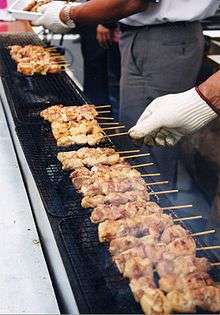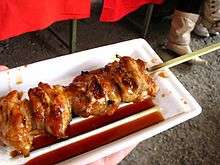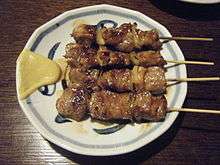Yakitori


Yakitori (Japanese: 焼き鳥, lit. grilled chicken) is a Japanese type of skewered chicken.
The preparation of Yakitori involves skewering the meat with kushi (串?) , a type of skewer typically made of steel, bamboo, or similar materials. Afterwards, they are grilled over a charcoal fire. During or after cooking, the meat is typically seasoned with tare sauce or salt.[1]
Preparation
As they are designed for convenience and portability, yakitori are typically cooked using methods that come step by step Traditionally, this was accomplished by using portable charcoal grills. This is the method most often employed by yatai, however, restaurants may use stationary grills, and depending on the situation, higher quality binchōtan charcoal.
For home use, various appliances known as takujō konro (卓上コンロ, "mini griller")[2] or yakitori-ki (焼き鳥器, "Yakitori device") are used. Yakitori-ki are small electrical appliances which use a heating element similar to that of a broiler or toaster to cook the food placed on top.

.jpg)
In order to facilitate even cooking, the meat is cut into small, roughly uniform shapes and then skewered with kushi; after which the yakitori are seasoned and cooked. Charcoal is the preferred method of cooking as it produces high heat and strong flames while giving off little to no water vapor. This allows for the ingredients to cook quickly while imparting a crunchy texture to the skin. While gas and electric heat sources can be used, they do not develop the same aromas or textures as charcoal-cooked yakitori.
Seasoning
Yakitori seasonings are primarily divided among two types: salty or salty-sweet. The salty type usually uses plain salt as its main seasoning. For the salty-sweet variety, tare, a special sauce consisting of mirin, sake, soy sauce, and sugar is used. Other common spices include powdered cayenne pepper, shichimi, Japanese pepper, black pepper, and wasabi, according to one's tastes.
Sales
Yakitori-ya (焼き鳥屋) are small shops specializing in yakitori. They usually take the form of a compact shop offering take-out services only,[3] but sit-down restaurants and restaurant chains are also popular.[1]
Yakitori isn't limited to speciality shops, however. It is readily found on the menus of izakaya all across Japan, and also sold pre-cooked, as frozen vacuum packs, or even canned, the latter of which was made popular by Hotei Foods Corporation which is the first company that started selling yakitori-in-can in 1970,[4] with 9 flavors as of 2016. Their TV commercial song has been iconic to their brand name.[5] Due to its ease of preparation and portability, yakitori is a very popular street food, often sold from small carts and stalls known as yatai. Yatai are found, among other places, dotting streets during festivals or on heavily trafficked routes during the evening commute where customers will enjoy beer and sake with yakitori.[6]
Kushiyaki
Kushiyaki (串焼き), is a formal term that encompasses both poultry and non-poultry items, skewered and grilled. Both yakitori and kushiyaki are used interchangeably in Japanese society to refer to skewered meat collectively; however, when referring to a specific item, yakitori will not be used unless the primary meat is chicken. While using pork, grilled pork on skewers are cooked with the same sauce as yakitori, and that is why in some areas as Muroran, grilled pork on skewers are called "yakitori", instead of yakiton (やきとん, skewered and grilled pork).
Examples
Yakitori
Due to a wide diversity in cuts and preparation methods,[1] yakitori takes on many forms. Some popular examples include:
- momo (もも), chicken thigh
- "negima" (ねぎま), chicken and spring onion
- tsukune (つくね), chicken meatballs
- (tori)kawa ((とり)かわ), chicken skin, grilled until crispy
- tebasaki (手羽先), chicken wing
- bonjiri (ぼんじり), chicken tail
- shiro (シロ), chicken small intestines
- nankotsu (なんこつ), chicken cartilage
- hāto / hatsu (ハート / ハツ) or kokoro (こころ), chicken heart
- rebā (レバー), liver
- sunagimo (砂肝) or zuri (ずり), chicken gizzard
- toriniku (鶏肉), all white meat on skewer
- yotsumi (四つ身), pieces of chicken breast
Kushiyaki
The following examples are not yakitori in the strictest sense of the word, and are better classified as "kushiyaki", as they do not use poultry.
- gyūtan (牛タン), beef tongue, sliced thinly
- butabara (豚ばら), pork back ribs
- ikada (筏) (lit. raft), Japanese scallion, with two skewers to prevent rotation
- atsuage tōfu (厚揚げとうふ), thicker variety of deep-fried tofu
- enoki maki (エノキ巻き), enoki mushrooms wrapped in slices of pork
- pīman (ピーマン), green bellpepper
- asuparabēkon (アスパラベーコン), asparagus wrapped in bacon
- ninniku (にんにく), garlic
- shishitō (獅子唐), Japanese pepper

Gallery

 chicken liver
chicken liver Left to right: Asuparamaki (Asparagus wrapped in thinly sliced pork, with chicken wing yakitori)
Left to right: Asuparamaki (Asparagus wrapped in thinly sliced pork, with chicken wing yakitori) Ginkgo nuts
Ginkgo nuts Left to right: Tsukune; negi (scallion) and butabara (pork back ribs)
Left to right: Tsukune; negi (scallion) and butabara (pork back ribs) Negima (chicken thigh and scallion)
Negima (chicken thigh and scallion)
See also
- Japanese cuisine
- List of chicken dishes
- Satay - similar skewered food in Southeast Asia
- Souvlaki - similar skewered food in Greece
- Brochette - similar skewered food in France
- Chuanr - similar skewered food in China
- Dakkochi - similar skewered food in Korea
- Nem nướng - similar skewered food in Vietnam
- Shashlik
References
- ↑ "jūshībōi". Retrieved 2016-02-14.
- ↑ Kawaguchi, Judit. "People - Words to Live by: Chicken one day doesn't mean feathers on the next". the Japan Times. Retrieved 2016-02-14.
- ↑ "catalog - cooked meat cans". Hotei Foods Corporation. Retrieved 2016-02-14.
- ↑ "CM gallery". Retrieved 2016-02-14.
- ↑ Goss, Rob (2014-11-18). Tokyo Tuttle Travel Pack: Your Guide to Tokyo's Best Sights for Every Budget. Tokyo: Tuttle Publishing. p. 66.
See also
- Jarinko Chie
Further reading
- Ono, Tadashi; Salat Harris (2011). The Japanese Grill: From Classic Yakitori to Steak, Seafood, and Vegetables. Ten Speed Press. ISBN 9781580087377
- Itoh, Makiko (2015-08-21). "How yakitori went from taboo to salaryman snack". the Japan Times. Tokyo. Retrieved 2016-02-14.
- "Yakitori (Roast meat on skewers)". Gurunavi. Retrieved 2016-02-14.
External links
| Wikimedia Commons has media related to Yakitori. |
